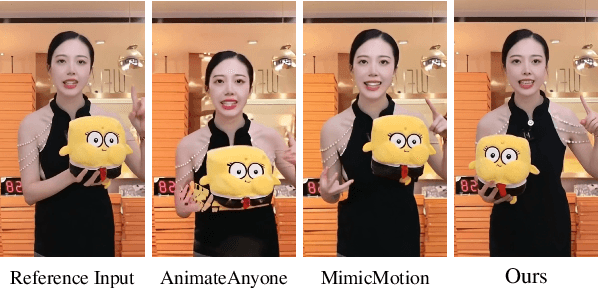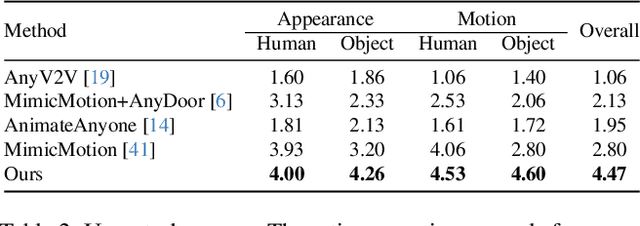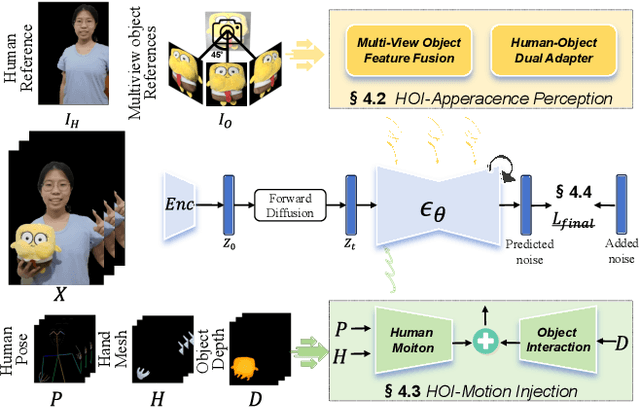Juan Cao
AnchorCrafter: Animate CyberAnchors Saling Your Products via Human-Object Interacting Video Generation
Nov 26, 2024



Abstract:The automatic generation of anchor-style product promotion videos presents promising opportunities in online commerce, advertising, and consumer engagement. However, this remains a challenging task despite significant advancements in pose-guided human video generation. In addressing this challenge, we identify the integration of human-object interactions (HOI) into pose-guided human video generation as a core issue. To this end, we introduce AnchorCrafter, a novel diffusion-based system designed to generate 2D videos featuring a target human and a customized object, achieving high visual fidelity and controllable interactions. Specifically, we propose two key innovations: the HOI-appearance perception, which enhances object appearance recognition from arbitrary multi-view perspectives and disentangles object and human appearance, and the HOI-motion injection, which enables complex human-object interactions by overcoming challenges in object trajectory conditioning and inter-occlusion management. Additionally, we introduce the HOI-region reweighting loss, a training objective that enhances the learning of object details. Extensive experiments demonstrate that our proposed system outperforms existing methods in preserving object appearance and shape awareness, while simultaneously maintaining consistency in human appearance and motion. Project page: https://cangcz.github.io/Anchor-Crafter/
Interactive Visual Assessment for Text-to-Image Generation Models
Nov 23, 2024Abstract:Visual generation models have achieved remarkable progress in computer graphics applications but still face significant challenges in real-world deployment. Current assessment approaches for visual generation tasks typically follow an isolated three-phase framework: test input collection, model output generation, and user assessment. These fashions suffer from fixed coverage, evolving difficulty, and data leakage risks, limiting their effectiveness in comprehensively evaluating increasingly complex generation models. To address these limitations, we propose DyEval, an LLM-powered dynamic interactive visual assessment framework that facilitates collaborative evaluation between humans and generative models for text-to-image systems. DyEval features an intuitive visual interface that enables users to interactively explore and analyze model behaviors, while adaptively generating hierarchical, fine-grained, and diverse textual inputs to continuously probe the capability boundaries of the models based on their feedback. Additionally, to provide interpretable analysis for users to further improve tested models, we develop a contextual reflection module that mines failure triggers of test inputs and reflects model potential failure patterns supporting in-depth analysis using the logical reasoning ability of LLM. Qualitative and quantitative experiments demonstrate that DyEval can effectively help users identify max up to 2.56 times generation failures than conventional methods, and uncover complex and rare failure patterns, such as issues with pronoun generation and specific cultural context generation. Our framework provides valuable insights for improving generative models and has broad implications for advancing the reliability and capabilities of visual generation systems across various domains.
HeadRouter: A Training-free Image Editing Framework for MM-DiTs by Adaptively Routing Attention Heads
Nov 22, 2024



Abstract:Diffusion Transformers (DiTs) have exhibited robust capabilities in image generation tasks. However, accurate text-guided image editing for multimodal DiTs (MM-DiTs) still poses a significant challenge. Unlike UNet-based structures that could utilize self/cross-attention maps for semantic editing, MM-DiTs inherently lack support for explicit and consistent incorporated text guidance, resulting in semantic misalignment between the edited results and texts. In this study, we disclose the sensitivity of different attention heads to different image semantics within MM-DiTs and introduce HeadRouter, a training-free image editing framework that edits the source image by adaptively routing the text guidance to different attention heads in MM-DiTs. Furthermore, we present a dual-token refinement module to refine text/image token representations for precise semantic guidance and accurate region expression. Experimental results on multiple benchmarks demonstrate HeadRouter's performance in terms of editing fidelity and image quality.
DragEntity: Trajectory Guided Video Generation using Entity and Positional Relationships
Oct 14, 2024Abstract:In recent years, diffusion models have achieved tremendous success in the field of video generation, with controllable video generation receiving significant attention. However, existing control methods still face two limitations: Firstly, control conditions (such as depth maps, 3D Mesh) are difficult for ordinary users to obtain directly. Secondly, it's challenging to drive multiple objects through complex motions with multiple trajectories simultaneously. In this paper, we introduce DragEntity, a video generation model that utilizes entity representation for controlling the motion of multiple objects. Compared to previous methods, DragEntity offers two main advantages: 1) Our method is more user-friendly for interaction because it allows users to drag entities within the image rather than individual pixels. 2) We use entity representation to represent any object in the image, and multiple objects can maintain relative spatial relationships. Therefore, we allow multiple trajectories to control multiple objects in the image with different levels of complexity simultaneously. Our experiments validate the effectiveness of DragEntity, demonstrating its excellent performance in fine-grained control in video generation.
Visual-Friendly Concept Protection via Selective Adversarial Perturbations
Aug 16, 2024Abstract:Personalized concept generation by tuning diffusion models with a few images raises potential legal and ethical concerns regarding privacy and intellectual property rights. Researchers attempt to prevent malicious personalization using adversarial perturbations. However, previous efforts have mainly focused on the effectiveness of protection while neglecting the visibility of perturbations. They utilize global adversarial perturbations, which introduce noticeable alterations to original images and significantly degrade visual quality. In this work, we propose the Visual-Friendly Concept Protection (VCPro) framework, which prioritizes the protection of key concepts chosen by the image owner through adversarial perturbations with lower perceptibility. To ensure these perturbations are as inconspicuous as possible, we introduce a relaxed optimization objective to identify the least perceptible yet effective adversarial perturbations, solved using the Lagrangian multiplier method. Qualitative and quantitative experiments validate that VCPro achieves a better trade-off between the visibility of perturbations and protection effectiveness, effectively prioritizing the protection of target concepts in images with less perceptible perturbations.
FakingRecipe: Detecting Fake News on Short Video Platforms from the Perspective of Creative Process
Jul 23, 2024Abstract:As short-form video-sharing platforms become a significant channel for news consumption, fake news in short videos has emerged as a serious threat in the online information ecosystem, making developing detection methods for this new scenario an urgent need. Compared with that in text and image formats, fake news on short video platforms contains rich but heterogeneous information in various modalities, posing a challenge to effective feature utilization. Unlike existing works mostly focusing on analyzing what is presented, we introduce a novel perspective that considers how it might be created. Through the lens of the creative process behind news video production, our empirical analysis uncovers the unique characteristics of fake news videos in material selection and editing. Based on the obtained insights, we design FakingRecipe, a creative process-aware model for detecting fake news short videos. It captures the fake news preferences in material selection from sentimental and semantic aspects and considers the traits of material editing from spatial and temporal aspects. To improve evaluation comprehensiveness, we first construct FakeTT, an English dataset for this task, and conduct experiments on both FakeTT and the existing Chinese FakeSV dataset. The results show FakingRecipe's superiority in detecting fake news on short video platforms.
Pruning for Robust Concept Erasing in Diffusion Models
May 26, 2024Abstract:Despite the impressive capabilities of generating images, text-to-image diffusion models are susceptible to producing undesirable outputs such as NSFW content and copyrighted artworks. To address this issue, recent studies have focused on fine-tuning model parameters to erase problematic concepts. However, existing methods exhibit a major flaw in robustness, as fine-tuned models often reproduce the undesirable outputs when faced with cleverly crafted prompts. This reveals a fundamental limitation in the current approaches and may raise risks for the deployment of diffusion models in the open world. To address this gap, we locate the concept-correlated neurons and find that these neurons show high sensitivity to adversarial prompts, thus could be deactivated when erasing and reactivated again under attacks. To improve the robustness, we introduce a new pruning-based strategy for concept erasing. Our method selectively prunes critical parameters associated with the concepts targeted for removal, thereby reducing the sensitivity of concept-related neurons. Our method can be easily integrated with existing concept-erasing techniques, offering a robust improvement against adversarial inputs. Experimental results show a significant enhancement in our model's ability to resist adversarial inputs, achieving nearly a 40% improvement in erasing the NSFW content and a 30% improvement in erasing artwork style.
Let Silence Speak: Enhancing Fake News Detection with Generated Comments from Large Language Models
May 26, 2024



Abstract:Fake news detection plays a crucial role in protecting social media users and maintaining a healthy news ecosystem. Among existing works, comment-based fake news detection methods are empirically shown as promising because comments could reflect users' opinions, stances, and emotions and deepen models' understanding of fake news. Unfortunately, due to exposure bias and users' different willingness to comment, it is not easy to obtain diverse comments in reality, especially for early detection scenarios. Without obtaining the comments from the ``silent'' users, the perceived opinions may be incomplete, subsequently affecting news veracity judgment. In this paper, we explore the possibility of finding an alternative source of comments to guarantee the availability of diverse comments, especially those from silent users. Specifically, we propose to adopt large language models (LLMs) as a user simulator and comment generator, and design GenFEND, a generated feedback-enhanced detection framework, which generates comments by prompting LLMs with diverse user profiles and aggregating generated comments from multiple subpopulation groups. Experiments demonstrate the effectiveness of GenFEND and further analysis shows that the generated comments cover more diverse users and could even be more effective than actual comments.
Break-for-Make: Modular Low-Rank Adaptations for Composable Content-Style Customization
Mar 31, 2024



Abstract:Personalized generation paradigms empower designers to customize visual intellectual properties with the help of textual descriptions by tuning or adapting pre-trained text-to-image models on a few images. Recent works explore approaches for concurrently customizing both content and detailed visual style appearance. However, these existing approaches often generate images where the content and style are entangled. In this study, we reconsider the customization of content and style concepts from the perspective of parameter space construction. Unlike existing methods that utilize a shared parameter space for content and style, we propose a learning framework that separates the parameter space to facilitate individual learning of content and style, thereby enabling disentangled content and style. To achieve this goal, we introduce "partly learnable projection" (PLP) matrices to separate the original adapters into divided sub-parameter spaces. We propose "break-for-make" customization learning pipeline based on PLP, which is simple yet effective. We break the original adapters into "up projection" and "down projection", train content and style PLPs individually with the guidance of corresponding textual prompts in the separate adapters, and maintain generalization by employing a multi-correspondence projection learning strategy. Based on the adapters broken apart for separate training content and style, we then make the entity parameter space by reconstructing the content and style PLPs matrices, followed by fine-tuning the combined adapter to generate the target object with the desired appearance. Experiments on various styles, including textures, materials, and artistic style, show that our method outperforms state-of-the-art single/multiple concept learning pipelines in terms of content-style-prompt alignment.
U-VAP: User-specified Visual Appearance Personalization via Decoupled Self Augmentation
Mar 29, 2024



Abstract:Concept personalization methods enable large text-to-image models to learn specific subjects (e.g., objects/poses/3D models) and synthesize renditions in new contexts. Given that the image references are highly biased towards visual attributes, state-of-the-art personalization models tend to overfit the whole subject and cannot disentangle visual characteristics in pixel space. In this study, we proposed a more challenging setting, namely fine-grained visual appearance personalization. Different from existing methods, we allow users to provide a sentence describing the desired attributes. A novel decoupled self-augmentation strategy is proposed to generate target-related and non-target samples to learn user-specified visual attributes. These augmented data allow for refining the model's understanding of the target attribute while mitigating the impact of unrelated attributes. At the inference stage, adjustments are conducted on semantic space through the learned target and non-target embeddings to further enhance the disentanglement of target attributes. Extensive experiments on various kinds of visual attributes with SOTA personalization methods show the ability of the proposed method to mimic target visual appearance in novel contexts, thus improving the controllability and flexibility of personalization.
 Add to Chrome
Add to Chrome Add to Firefox
Add to Firefox Add to Edge
Add to Edge